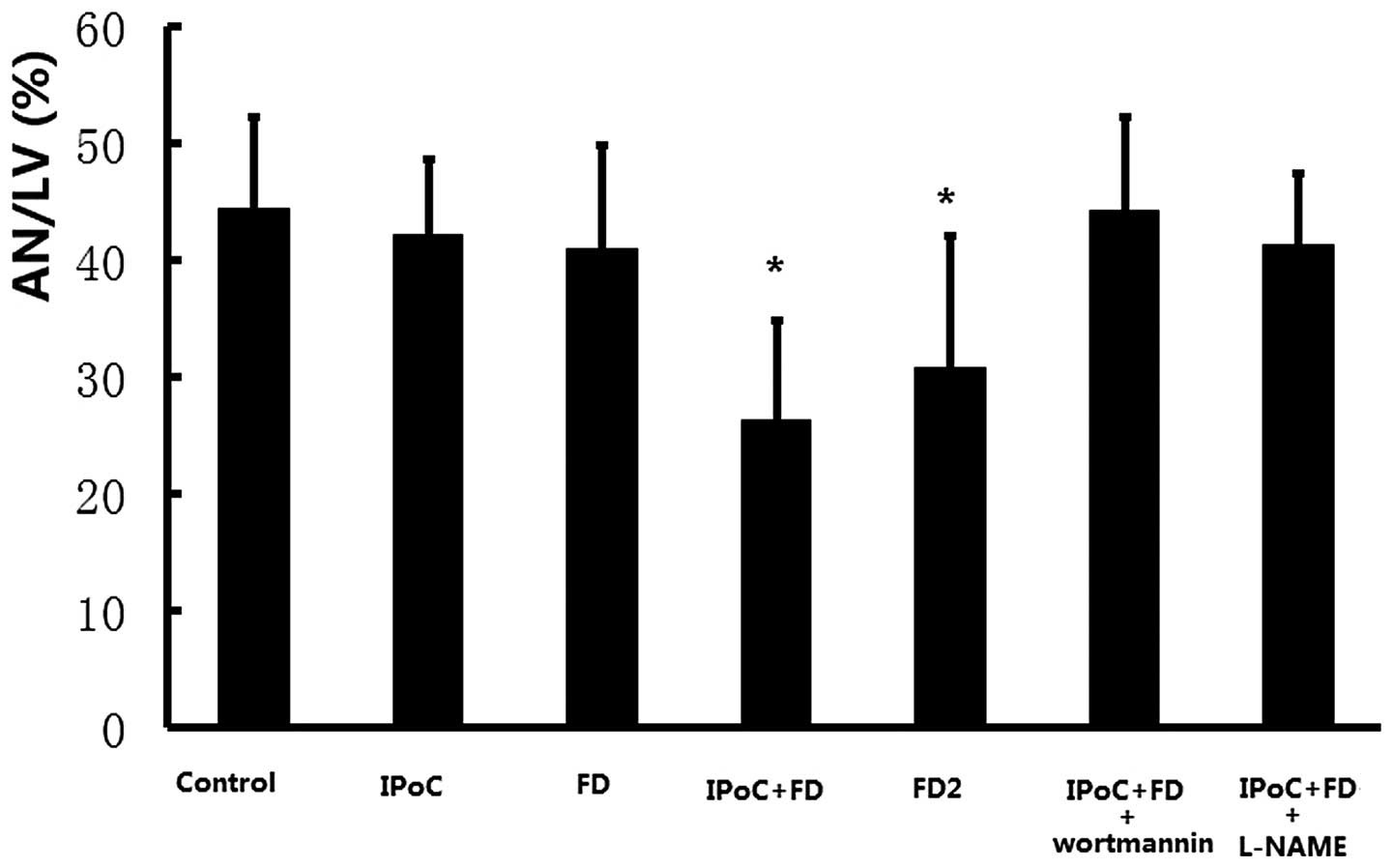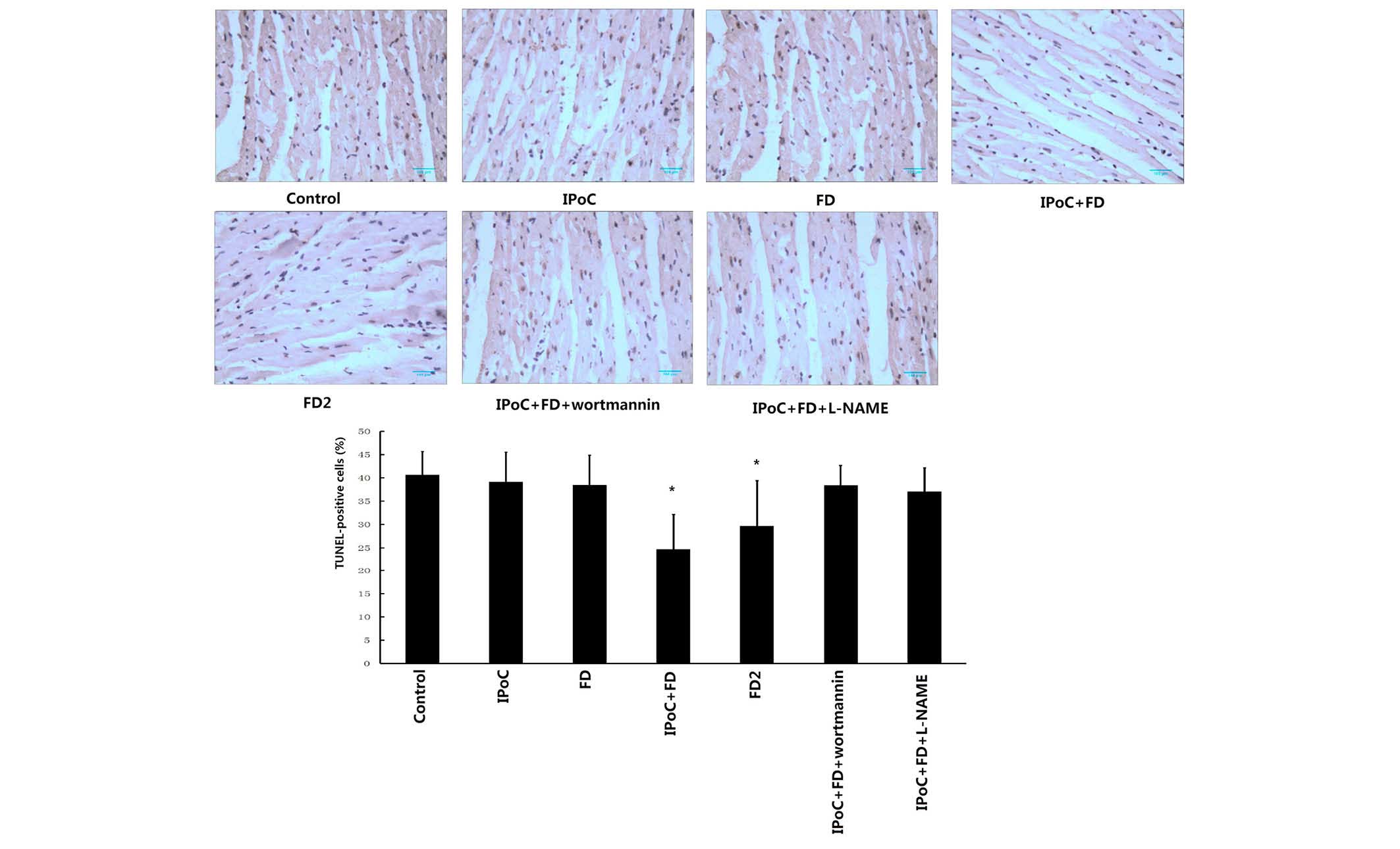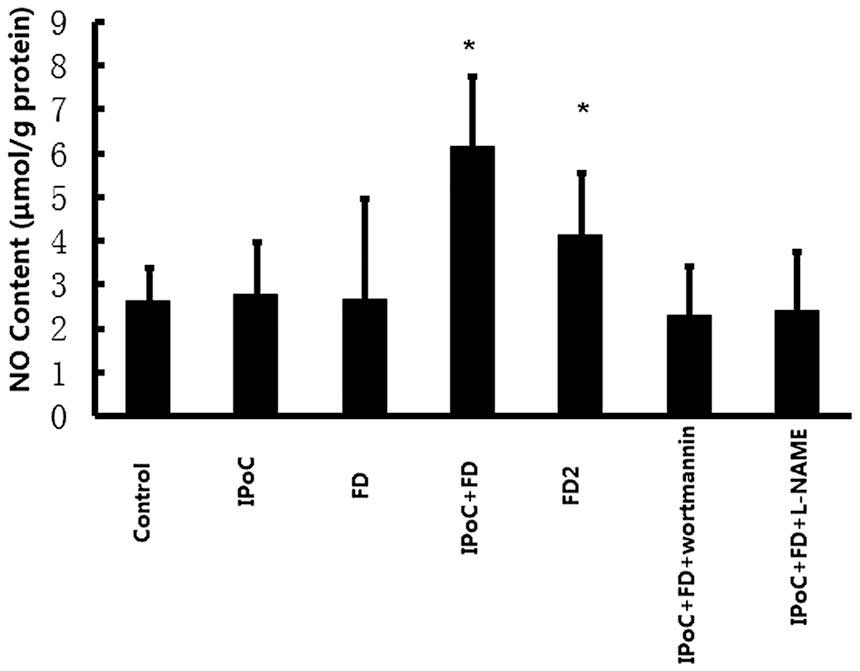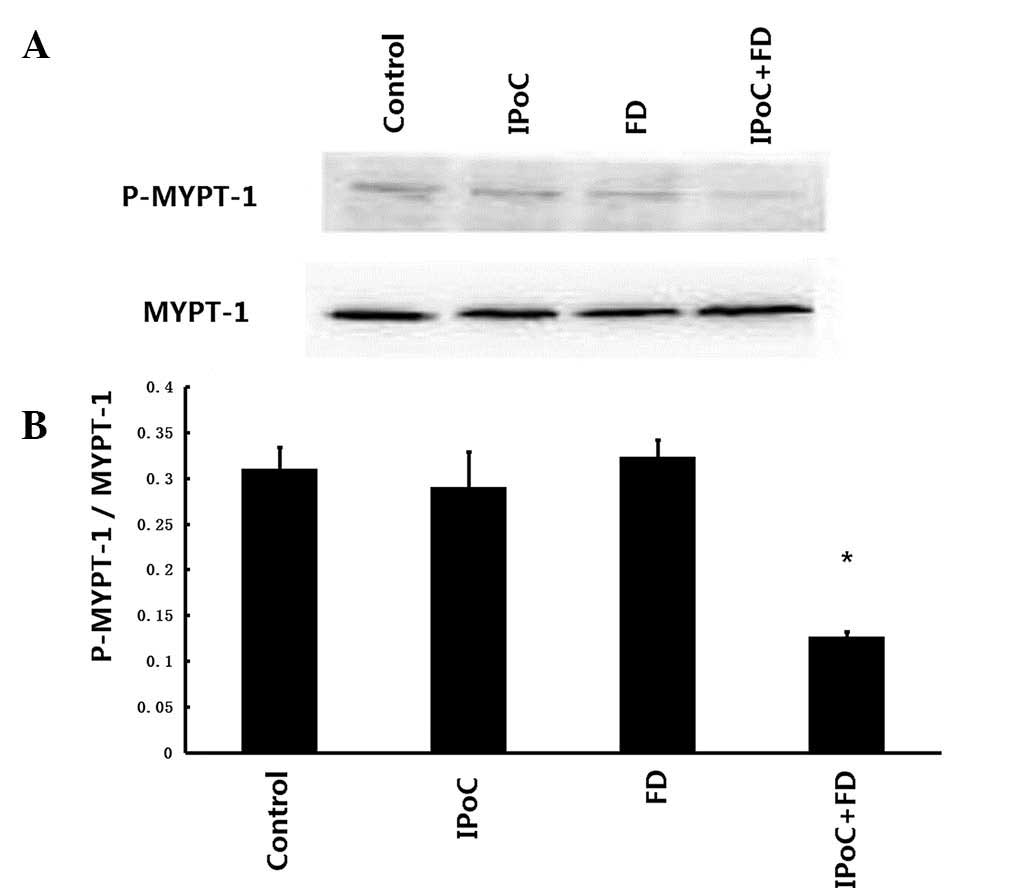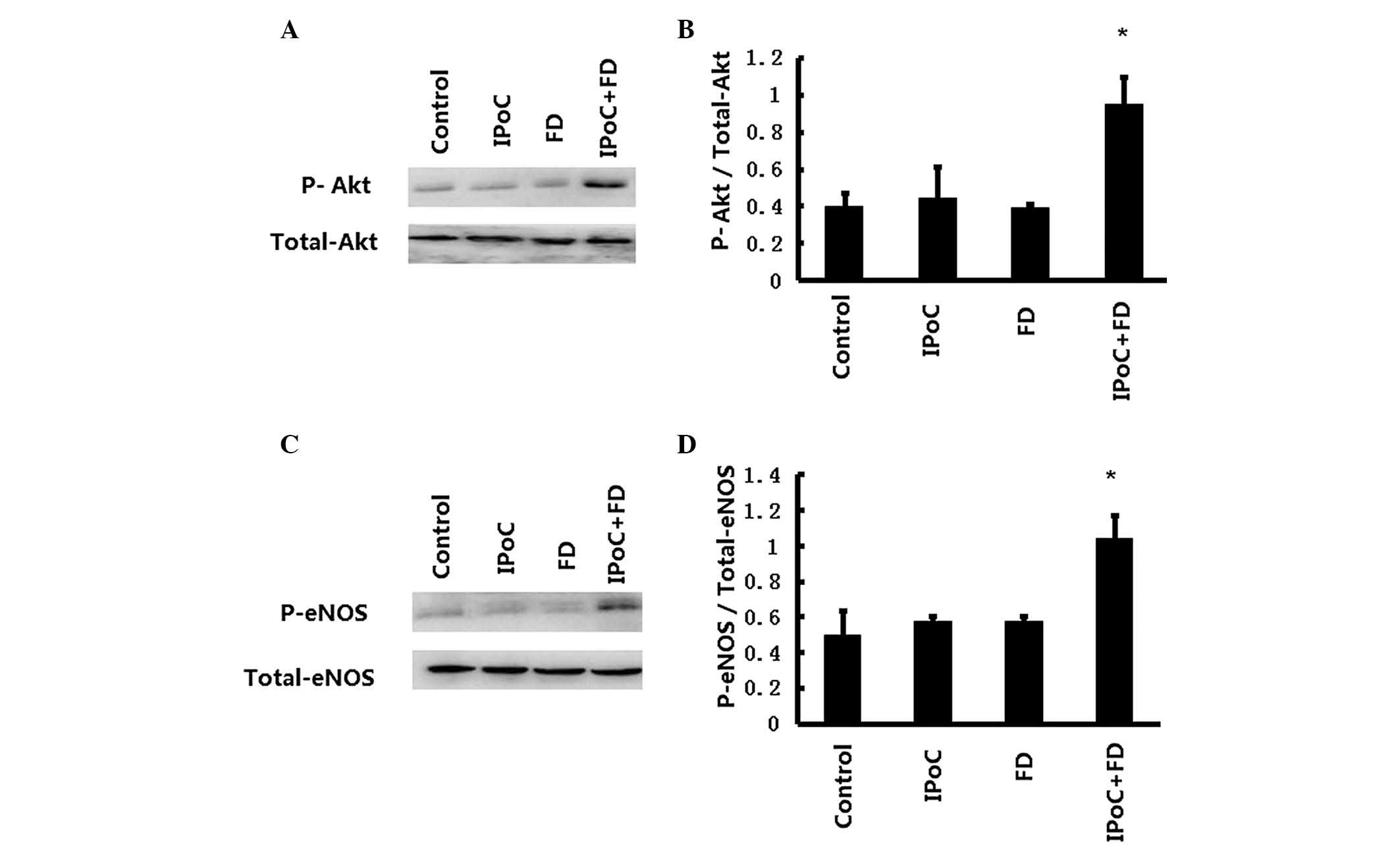Inhibition of Rho-kinase by fasudil restores the cardioprotection of ischemic postconditioninng in hypercholesterolemic rat heart
- Authors:
- Published online on: September 15, 2014 https://doi.org/10.3892/mmr.2014.2566
- Pages: 2517-2524
Abstract
Introduction
Ischemic postconditioning (IPoC), a short series of repetitive cycles of brief reperfusion and ischemia performed immediately following sustained ischemia, has been found to reduce myocardial ischemia reperfusion injury (1). The cardioprotection of IPoC has been proved in several animal models and even in the human heart (2–4). Although existing data in the literature remain contradictory, the majority of studies have demonstrated that hypercholesterolemia interferes with the cardioprotective effect of IPoC (5–8). However, the mechanism underlying the attenuation of the cardioprotective effects of IPoC in hypercholesterolemic conditions is not well understood.
Previously, several studies have demonstrated that hypercholesterolemia abrogates cardioprotection of IPoC or sevoflurane-induced preconditioning involved in inhibiting the activation of phosphatidylinositol 3-kinase (PI3K)/Akt/endothelial nitric oxide synthase (eNOS) pathway (9–11). Furthermore, pravastatin, a 3-hydroxy-3-methylglutaryl-CoA (HMG-CoA) reductase inhibitor, has been proved to be able to restore the cardioprotection of IPoC in hypercholesterolemic states by upregulating the PI3K/Akt/eNOS pathway, which is possibly independent of its lipid-lowing effect (9).
A number of studies have demonstrated that fasudil, a Rho-kinase inhibitor, had beneficial effects in diverse cardiovascular diseases, including ischemic heart disease, atherosclerosis, myocardial hypertrophy and heart failure (12–15). Furthermore, fasudil has been reported to lead to the activation of the PI3K/Akt/eNOS pathway, resulting in preconditioning and postconditioning against myocardial ischemia reperfusion injury (16–18). Therefore, it was hypothesized that fasudil may restore the cardioprotection of IPoC in the presence of hypercholesterolemia.
Based on this hypothesis, the present study examined whether the administration of fasudil shortly prior to ischemia may restore the cardioprotection of IPoC in the presence of hypercholesterolemia. Furthermore, in order to determine the potential underlying mechanisms, the myocardial NO content and Rho-kinase activity, as well as the activation of PI3K/Akt/eNOS pathway in this process, were assessed.
Materials and methods
Animals
A total of 105 male Wistar rats purchased from the Center of Experimental Animals, China Medical University (Shenyang, Liaoning, China), weighing 200±10 g were used in the present study. All of the animals used in this study were treated in accordance with the Guide for the Care and Use of Laboratory Animals, published by the National Institutes of Health (NIH). The study procedure was approved by the institutional Ethics Committee of China Medical University (Shenyang, China).
Drugs
Fasudil was purchased from Chase Sun Pharmaceutical Company (Tianjin, China). Wortmannin, L-NAME and 2,3,5-triphenyl tetrazoliumchloride (TTC) were purchased from Sigma (St. Louis, MO, USA).
Induction of experimental hypercholesterolemia
Prior to the initiation of the 8-week feeding period, the blood samples were obtained from the rats’ vena caudalis for determination of the plasma levels of total cholesterol (TC), low density lipoprotein (LDL) and high density lipoprotein (HDL) using commercial kits (Total Cholesterol Assay kit - Fluoro Cholesterol; Cell Technology, Mountain View, CA, USA; Cholesterol LDL direct; Biosystems S.A., Barcelona, Spain; and Cholesterol HDL direct, Biosystems S.A). All of the animals were fed with a diet enriched with 1.5% cholesterol, 5% egg yolk powder, 10% lard, 0.5% sodium cholate, 3% sugar and 80% normal feed for 8 weeks, and this formula was modified as previously described (19). Following the 8-week feeding period, the blood samples were obtained from the rats’ vena caudalis again for determination of serum lipid in order to judge the success of hypercholesterolemic models.
Heart preparation
The rats were anesthetized with an intraperitoneal injection of pentobarbital sodium (100 mg/kg). Heparin (1,500 IU/kg) was administered intravenously to prevent intracoronary clot formation. The heart was rapidly excised and immediately immersed in ice-cold heparinized modified Krebs-Henseleit buffer containing (in per mmol) 127 NaCl, 17.7 NaHCO3, 5.1 KCl, 1.5 CaCl2, 1.26 MgCl2 and 11D-glucose (pH 7.4). The heart was mounted on a Langendorff-perfusion apparatus and retrogradely perfused through the aorta with recirculating buffer saturated with 95% O2-5% CO2 at 37°C. The heart was maintained in a thermostatic chamber at 37°C. Perfusion was maintained at a constant pressure of 75 mmHg. The fluid-filled latex balloon was inserted in the left ventricle (LV) via the left atrium for pressure measurement. The balloon was connected to a pressure transducer and inflated to an initial LV end-diastolic pressure between 8 and 10 mmHg.
Experimental procedure
The rats were further divided into seven groups with 15 animals/group. In all of the groups, the isolated rat hearts were perfused with a K-H solution (127 mM NaCl, 17.7 mM NaHCO3, 5.1 mM KCl, 1.5 mM CaCl2, 1.26 mM MgCl2 and 11mM D-glucose, pH 7.4) and allowed 10 min of stabilization. Next, all of the isolated rat hearts were subjected to 30 min global ischemia and 120 min reperfusion.
In the control group, the isolated rat hearts were subjected to 30 min global ischemia and 120 min reperfusion. For the ischemic postconditioning group (IPoC group): the isolated rat hearts were subject to ischemia for 30 min, followed by six cycles of reperfusion and ischemia, both with equal lengths of 10 sec and reperfusion for 120 min. In the fasudil preconditioning group (FD group), the isolated rat hearts were perfused with K-H solution containing 1 μM dose fasudil 15 min prior to ischemia. In the ischemic postconditioning+fasudil group (IPoC+FD group), 1 μM fasudil was added to the perfusate for 15 min prior to ischemia, then 30 min ischemia was followed by six cycles of reperfusion and ischemia, both with equal lengths of 10 sec and reperfusion for 120 min.
To investigate whether a higher concentration of fasudil alone was able to restore cardioprotection in hypercholesterolemic rat heart, an additional group with 10 μM fasudil treatment prior ischemia was also established. In the high dose fasudil preconditioning group (FD2 group), the isolated rat hearts were perfused with K-H solution containing 10 μM fasudil 15 min prior to ischemia
To further determine whether the PI3K/Akt/eNOS pathway participated in regulating fasudil restored cardioprotection of IPoC in the state of hypercholesterolemia, two more groups were added to the experimental studies, with PI3K specific inhibitor wortmannin and eNOS specific inhibitor L-NAME treatment. In the ischemic postconditioning+fasudil+wortmannin group (IPoC+FD+wortmannin group), wortmannin at the dose of 30 μM was administrated immediately following IPoC. The ischemic postconditioning and fasudil preconditioning were performed as described above. In the ischemic postconditioning+fasudil+L-NAME group (IPoC+FD+L-NAME group), L-NAME at the dose of 30 μM was administrated immediately following IPoC. Ischemic postconditioning and fasudil preconditioning were conducted as described above.
Hemodynamic monitoring
The homodynamic assessment included heart rate (HR), left ventricular developed pressure (LVDP), positive first order derivative of ventricular pressure (+dp/dt) and negative first order derivative of ventricular pressure (−dp/dt). These parameters were continuously monitored throughout the experimental procedures. The HR, LVDP, +dp/dt and −dp/dt were sampled and digitally processed via a homodynamic system (BIOPAC MP150; BIOPAC systems, Goleta, CA, USA).
Measurement of infarct size
The infarct size was determined as previously described (20). Briefly, following 2 h reperfusion, the hearts were harvested and the LVs were sectioned from the apex to the base into 2–3 mm sections, following incubation for 20 min at 37°C in 1% triphenyltetrazolium chloride (TTC). The unstained tissue was carefully separated from the stained tissue by an independent observer. While the unstained tissue represented the dead cells, the stained tissue represented the viable cells. The unstained mass was expressed as a percentage of total LV mass. The total LV mass also corresponded to the risk area because a global ischemia was induced.
Measurement of myocardial apoptosis
At the end of 2 h reperfusion, the heart was removed as described above. Cardiomyocyte apoptosis was detected using an In Situ Cell Death Detection kit (Roche, South San Francisco, CA, USA) according to the manufacturer’s instructions. Briefly, the tissue sections were washed in PBS and then fixed in 4% paraformaldehyde solution prior to incubation in 20 μg/ml proteinase K for 10 min. Following being washed in PBS for three times, the tissue sections were incubated with terminal deoxynucleotidyl transferase enzyme (TUNEL) in a humidified chamber at 37°C for 60 min for incorporation of the biotinylated nucleotides at the 3′-OH DNA ends. The reaction was terminated by transferring the slides to a 2× sodium citrate saline solution. Endogenous peroxidase activity was quenched by incubation in 0.3% hydrogen peroxide. Finally, streptavidin horseradish peroxidase was bound to the biotinylated nucleotides and the peroxidase activity was demonstrated in each section by the application of a stable chromogen diaminobenzidine. In this technique, the apoptotic nuclei are stained dark brown. The sections were counter stained with hematoxylin for total nuclei. Three sections from each myocardial sample were randomly selected and ten microscopic fields (Olympus BX51 microscope; Olympus, Tokyo, Japan) per section were evaluated by two independent blind observers. In each field, the nuclei were counted and the percentage of TUNEL-positive nuclei was calculated.
Measurements of NO content
After 30 min of global ischemia followed by 120 min of reperfusion, the hearts were removed rapidly from the Langendorff apparatus and homogenized. The content of NO was measured using Nitric Oxide assay kit (Nanjing Jiancheng Bioengineering Institute, Nanjing, China) according to the manufacturer’s instructions.
Western blotting
At the end of 30 min reperfusion, the LVs were homogenized in a lysis buffer [(in mmol/l) 10 Tris-HCl, 20 ortho-phosphate, 1 EGTA, 1 EDTA, 2 Na3VO4, 1 phenylmethylsulfonyl fluoride; pH 7.4]. Following sonication, the lysates were centrifuged, the proteins were separated by electrophoresis on SDS-PAGE and transferred onto polyvinylidenedifluoride-plus membranes. The membranes were blocked with 5% skimmed milk followed by incubation overnight at 4°C with the antibodies: MYPT-1 (1:300; Abcam); phospho-MYPT-1 (at Ser853,1:300; Abcam, Hong Kong, China); Akt (1:200; Santa Cruz Biotechnology Inc., Santa Cruz, CA, USA); phospho-Akt (at Ser473, 1:200; Santa Cruz Biotechnology, Inc.); eNOS (1:200; Santa Cruz Biotechnology Inc.); phospho-eNOS (at Ser1177, 1:200; Santa Cruz Biotechnology Inc.). Following incubation, the membranes were washed three times with 0.1% Tween-20 for 15 min and incubated with horseradish peroxidase for 2 h. The levels of phosphorylated proteins were normalized to their total protein levels. The relative densitometry was performed using a computerized software package (NIH Image 1.63 software).
Statistical analysis
The data are expressed as the mean ± standard deviation values. The statistical analysis was performed using Sigma Stat software version 3.5 (Systat software). The differences between the groups were evaluated using one-way analysis of variance, followed by Student-Newman-Keuls post hoc test. P<0.05 were considered to indicate a statistically significant difference.
Results
The levels of plasma lipids
Table I summarizes the average values for TC, HDL and LDL in the plasma of animals prior to and following the 8 week cholesterol-enriched diet. A significant increase (P<0.05) in the average TC and LDL values were observed in the animals fed with the cholesterol-enriched diet as compared with the control group. There was no significant difference in the value of HDL between the cholesterol-enriched diet group and the control group (P>0.05).
Hemodynamic changes
Table II demonstrates the values of HR, LVDP, +dp/dt and −dp/dt at baseline and different times of reperfusion. There were no significant differences among the groups in HR, LVDP, +dp/dt and −dp/dt at baseline. No significant differences in HR, LVDP, +dp/dt and −dp/dt were observed in the IPoC and FD groups compared with the control group (P>0.05). However, IPoC+FD group significantly increased the values of HR, LVDP, +dp/dt and −dp/dt at different times of reperfusion compared with the control group (P<0.05). Furthermore, high doses of fasudil treatment alone (FD2 group) also improved the values of HR, LVDP, +dp/dt and −dp/dt at different times of reperfusion compared with the control group (P<0.05).
Infarct size measurement
As demonstrated in Fig. 1, no significant decrease in infarct size was observed in IPoC group and FD group as compared with the control group (42.3±6.5 and 40.9±8.9%, respectively, vs. 44.4±7.9%, P>0.05). However, the IPoC+FD group had a significantly reduced infarct size as compared with the control group (26.3±8.5 vs. 44.4±7.9%, P<0.05), suggesting that low dose fasudil preconditioning restored the cardioprotection of IPoC in hypercholesterolemic conditions. In addition, a high dose of fasudil treatment alone (FD2 group) also reduced infarct size as compared with the control group (30.8±11.3 vs. 44.4±7.9%, P<0.05).
TUNEL staining for apoptosis
The percentage of apoptotic cardiomyocytes of all of the experimental groups is demonstrated in Fig. 2. The IPoC+FD group and FD2 group significantly reduced cardiomyocyte apoptosis as compared with the control group (24.7±4.5 and 29.6±9.8%, respectively, vs. 40.6±5.0%, P<0.05). However, IPoC and low dose of fasudil treatment alone failed to exert the anti-apoptosis effect, as evidenced by no significant decrease in the percentage of cardiomyocyte apoptosis in IPoC and FD groups, as compared with the control group (39.1±6.4 and 38.5±6.4%, respectively, vs. 40.6±5.0%, P>0.05).
Effects on NO content in rat myocardium
As revealed in Fig. 3, the content of NO in rat myocardium was significantly increased in the IPoC+FD group, as compared with the control group (6.15±1.60 vs. 2.60±0.78, P<0.05), but the content of NO was not increased in the IPoC and FD groups (2.77±1.20 and 2.65±2.31, respectively, vs. 2.60±0.78, P>0.05). High dose fasudil preconditioning also markedly enhanced the content of NO in the rat myocardium as compared with the control group (4.12±1.43 vs. 2.60±0.78, P<0.05).
Activity of Rho-kinase
The Rho-kinase activity was assessed by examining the phosphorylation of MYPT-1, a well-established Rho-kinase specific substrate. As demonstrated in Fig. 4A and B, IPoC+FD treatment resulted in a significant reduction in MYPT-1 phosphorylation as compared with the control group (0.126±0.006 vs. 0.310±0.024, P<0.05), whereas no significant decrease in MYPT-1 phosphorylation was revealed in the IPoC and FD groups (0.289±0.039 and 0.323±0.019, respectively, vs. 0.310±0.024, P>0.05).
Protein expression of Akt and eNOS
As demonstrated in Fig. 5A and B, the Akt phosphorylation was enhanced in IPoC+FD group, as compared with the control group (0.951±0.146 vs. 0.402±0.166, P<0.05), but there is no significant change in Akt phosphorylation in the IPoC and FD groups, as compared with the control group (0.445±0.170 and 0.390±0.024, respectively, vs. 0.402±0.166, P>0.05). Furthermore, as revealed in Fig. 5C and D, the eNOS phosphorylation was also enhanced in the IPoC+FD group as compared with the control group (1.043±0.124 vs. 0.516±0.037, P<0.05), whereas no significant change in eNOS phosphorylation was demonstrated in the IPoC and FD groups as compared with the control group (0.577±0.023 and 0.575±0.026, respectively, vs. 0.516±0.037, P>0.05).
Effects of wortmannin and L-NAME on the cardioprotection of fasudil combined with IPoC treatment
To further assess the role of PI3K/Akt/eNOS pathway in the restoration of cardioprotection of IPoC in hypercholesterolemic myocardium by fasudil, the PI3K/Akt specific inhibitor, wortmannin and eNOS specific inhibitor, L-NAME in fasudil combined with IPoC treatment group were administered. The results demonstrated that the cardioprotection of fasudil combined with IPoC treatment in hypercholesterolemic myocardium was abrogated by treatment with wortmannin and L-NAME alone, as evidenced by no significant differences in hemodynamic parameters, myocardial infarct size, the percentage of cardiomyocyte apoptosis and the content of NO were demonstrated in IPoC+FD group, as compared with the control group.
Discussion
The present study demonstrates for the first time, to the best of our knowledge, that administration of fasudil shortly prior to ischemia may restore the cardioprotection of IPoC in the presence of hypercholesterolemia, while it also enhances the phosphorylation of eNOS and Akt and confers significant increase in the content of NO. By contrast, the administration of fasudil at the same dose and IPoC alone do not appear to exert the cardioprotection in the presence of hypercholesterolemia.
IPoC is a powerful form of protection, but its effectiveness under pathological conditions is in dispute. A number of studies have reported that the cardioprotection of IPoC is limited in the presence of diabetes, hyperlipidemia, uremia and so on (21,22). Among these disease conditions, hyperlipidemia, particularly hypercholesterolemia, is regarded as an independent risk factor in the development of ischemic heart diseases, including myocardial infarction. In the present study, it was identified that the cardioprotection of IPoC was blocked by elevated level of blood hypercholesterolemia, which was induced by feeding the rats an 8-week hypercholesterolemic diet. The results of the present study are consistent with the data found in previous studies (5–8). However, Donato et al demonstrated that ischemic postconditioning reduces infarct size by activation of A1 receptors and K+ATP channels in both normal and hypercholesterolemic rabbits (23). The discrepancies may possibly be attributed to the animal species, duration of hyperlipidemia diet and presence/absence of significant coronary sclerosis. Furthermore, the present study investigated the influence of hypercholesterolemia on the efficacy of IPoC in the isolated rat heart, which is independent of the impact of coronary sclerosis. Therefore, isolated rat heart reperfusion appears to be a more suitable model to study the direct effect of hypercholesterolemia on the cardioprotective mechanisms of IPoC.
The mechanisms that hyperlipidemia/hypercholesterolemia abrogates the cardioprotective effects of ischemic postconditioning remain unclear. Kupai et al found experimental hyperlipidemia induced by cholesterol-enriched diet impaired the cardioprotective effect of postconditioning by alternating the nitrosative stress signal and increasing the production of several oxidants, including peroxynitrite and lipid peroxidation compounds (7). In addition, a long term (3-week) or a short-term (3-day) statin administration restored the infarct size-limiting effect of postconditioning in hypercholesterolemic rat heart, potentially by increasing the expression and activity of eNOS (9,24).
Previous studies have revealed that Rho-kinase, a serine/threonine kinase is involved in numerous cardiac pathological conditions (25). It is abnormally activated in ischemic myocardium, suggesting that abnormal activation of Rho-kinase may be correlated with ischemia-induced myocardial injury (26). In the present study, it was identified that hypercholesterolemia blocked the cardioprotection of IPoC, which was accompanied by with the upregulation of the activity of Rho-kinase, as evidenced by the elevated level of MYPT-1 phosphorylation, a marker of Rho-kinase activity, in the IPoC group. The present study further determined that 1 μM fasudil administration prior to ischemia restored the cardioprotection of IPoC by decreasing Rho-kinase activity as evidenced by a lower expression of MYPT-1 phosphorylation in the FD+IPoC group, whereas administration of fasudil at the same dose and IPoC alone were ineffective in decreasing the expression of MYPT-1 phosphorylation.
NO is an important messenger in cardiovascular regulation and also has an important role in protecting the myocardium against ischemia reperfusion injury (27). It was reported that L-arginine, a precursor of NO, improved post-ischemic functional recovery and limited infarct size in the isolated rat heart. Furthermore, the NOS inhibitor L-NAME eliminated the effect of L-arginine on ischemia reperfusion injury (28,29). The main source of cardiac NO is generated through eNOS expressed by coronary endothelial cells and cardiac myocytes, which is regulated by PI3K/Akt (30). Hypercholesterolemia is reported to blunt the infarct size-limiting effect of IPoC possibly by decreasing cardiac NO content (7). Hypercholesterolemia also decreases NO bioavailability by downregulating eNOS, in association with an increased production of oxygen-derived free radicals that may inactivate NO (31,32). It is reported that fasudil may lead to the activation of the PI3K/Akt/eNOS signaling pathway and increased the NO content of myocardium under the condition of ischemia reperfusion (16). In the present study, it was demonstrated fasudil restored the cardioprotection of IPoC in the hypercholesterolemic rat heart by elevating the phosphorylation of Akt and eNOS, and increasing the NO content of myocardium. The results suggested that fasudil restored the cardioprotection of IPoC in hypercholesterolemic rat heart possibly by upregulating PI3K/Akt/eNOS signal pathway to increase the synthesis of NO. This hypothesis was further confirmed as evidenced by the fact that the cardioprotective effects of fasudil combined with IPoC treatment in the hypercholesterolemic rat heart, were eliminated by administration of the PI3K specific inhibitor, wortmannin, and the eNOS specific inhibitor, L-NAME.
Compared with preconditioning which must be applied prior to an ischemic event, postconditiong has the advantage that it may be applied following sustained ischemia. It has a notably more extensive clinical applicability. However, mounting randomized controlled trials results have demonstrated that ST-elevation myocardial infarction patients perform IPoC during primary percutaneous coronary intervention does not reduce myocardial damage, and it may even aggravate myocardial reperfusion injury (33,34). The reason for such results may be that clinical patients tend to have numerous complications, including diabetes, hyperlipidemia, renal dysfunction etc. which may affect the effectiveness of IPoC. Therefore, using drugs that reverse the cardioprotection of IPoC in the state of hypercholesterolemia are of marked importance. The present study found that fasudil, a specific Rho-kinase inhibitor which is approved for human use, restores the protective effect of IPoC in hyperlipidemic/hypercholesterolemic animal heart. These data may provide a new drug to restore the cardioprotective effect of IPoC in patients with other pathological complications.
In conclusion, it was demonstrated that the inhibition of Rho-kinase by fasudil was able to restore the cardioprotection of IPoC in the hypercholesterolemic rat heart. The mechanism underlying this effect appears to involve the upregulation of PI3K/Akt/eNOS signal pathway and an increase in myocardial NO content.
Acknowledgements
The present study was supported by Liaoning Provincial Science and Technology Projects, Liaoning, China (grant no. 2013021011).
References
|
Zhao ZQ, Corvera JS, Halkos ME, et al: Inhibition of myocardial injury by ischemic postconditioning during reperfusion: comparison with ischemic preconditioning. Am J Physiol Heart Circ Physiol. 285:H579–H588. 2003.PubMed/NCBI | |
|
Schwartz LM and Lagranha CJ: Ischemic postconditioning during reperfusion activates Akt and ERK without protecting against lethal myocardial ischemia-reperfusion injury in pigs. Am J Physiol Heart Circ Physiol. 290:H1011–H1018. 2006. View Article : Google Scholar | |
|
Gross GJ, Gauthier KM, Moore J, et al: Evidence for role of epoxyeicosatrienoic acids in mediating ischemic preconditioning and postconditioning in dog. Am J Physiol Heart Circ Physiol. 297:H47–H52. 2009. View Article : Google Scholar : PubMed/NCBI | |
|
Staat P, Rioufol G, Piot C, et al: Postconditioning the human heart. Circulation. 112:2143–2148. 2005. View Article : Google Scholar : PubMed/NCBI | |
|
Iliodromitis EK, Zoga A, Vrettou A, et al: The effectiveness of postconditioning and preconditioning on infarct size in hypercholesterolemic and normal anesthetized rabbits. Atherosclerosis. 188:356–362. 2006. View Article : Google Scholar : PubMed/NCBI | |
|
Zhao JL, Yang YJ, You SJ, Cui CJ and Gao RL: Different effects of postconditioning on myocardial no-reflow in the normal and hypercholesterolemic mini-swines. Microvasc Res. 73:137–142. 2007. View Article : Google Scholar : PubMed/NCBI | |
|
Kupai K, Csonka C, Fekete V, et al: Cholesterol diet-induced hyperlipidemia impairs the cardioprotective effect of postconditioning: role of peroxynitrite. Am J Physiol Heart Circ Physiol. 297:H1729–H1735. 2009. View Article : Google Scholar : PubMed/NCBI | |
|
Lauzier B, Delemasure S, Pesant M, et al: A cholesterol-rich diet improves resistance to ischemic insult in mouse hearts but suppresses the beneficial effect of post-conditioning. J Heart Lung Transplant. 28:821–826. 2009. View Article : Google Scholar | |
|
Andreadou I, Farmakis D, Prokovas E, et al: Short-term statin administration in hypercholesterolaemic rabbits resistant to postconditioning: effects on infarct size, endothelial nitric oxide synthase, and nitro-oxidative stress. Cardiovasc Res. 94:501–509. 2012. View Article : Google Scholar | |
|
Zhang FJ, Ma LL, Wang WN, et al: Hypercholesterolemia abrogates sevoflurane-induced delayed preconditioning against myocardial infarct in rats by alteration of nitric oxide synthase signaling. Shock. 37:485–491. 2012. View Article : Google Scholar | |
|
Ma LL, Zhang FJ, Qian LB, et al: Hypercholesterolemia blocked sevoflurane-induced cardioprotection against ischemia-reperfusion injury by alteration of the MG53/RISK/GSK3β signaling. Int J Cardiol. 168:3671–3678. 2013.PubMed/NCBI | |
|
Fukumoto Y, Mohri M, Inokuchi K, et al: Anti-ischemic effects of fasudil, a specific Rho-kinase inhibitor, in patients with stable effort angina. J Cardiovasc Pharmacol. 49:117–121. 2007. View Article : Google Scholar : PubMed/NCBI | |
|
Wu DJ, Xu JZ, Wu YJ, et al: Effects of fasudil on early atherosclerotic plaque formation and established lesion progression in apolipoprotein E-knockout mice. Atherosclerosis. 207:68–73. 2009. View Article : Google Scholar : PubMed/NCBI | |
|
Ho TJ, Huang CC, Huang CY and Lin WT: Fasudil, a Rho-kinase inhibitor, protects against excessive endurance exercise training-induced cardiac hypertrophy, apoptosis and fibrosis in rats. Eur J Appl Physiol. 112:2943–2955. 2012. View Article : Google Scholar | |
|
Wang N, Guan P, Zhang JP, et al: Fasudil hydrochloride hydrate, a Rho-kinase inhibitor, suppresses isoproterenol-induced heart failure in rats via JNK and ERK1/2 pathways. J Cell Biochem. 112:1920–1929. 2011. View Article : Google Scholar : PubMed/NCBI | |
|
Wolfrum S, Dendorfer A, Rikitake Y, et al: Inhibition of Rho-kinase leads to rapid activation of phosphatidylinositol 3-kinase/protein kinase Akt and cardiovascular protection. Arterioscler Thromb Vasc Biol. 24:1842–1847. 2004. View Article : Google Scholar : PubMed/NCBI | |
|
Li Y, Zhu W, Tao J, et al: Fasudil protects the heart against ischemia-reperfusion injury by attenuating endoplasmic reticulum stress and modulating SERCA activity: the differential role for PI3K/Akt and JAK2/STAT3 signaling pathways. PLoS One. 7:e481152012. View Article : Google Scholar | |
|
Jiang ZH, Zhang TT and Zhang JF: Protective effects of fasudil hydrochloride post-conditioning on acute myocardial ischemia/reperfusion injury in rats. Cardiol J. 20:197–202. 2013. View Article : Google Scholar : PubMed/NCBI | |
|
Zhao H, Wang Y, Wu Y, et al: Hyperlipidemia does not prevent the cardioprotection by postconditioning against myocardial ischemia/reperfusion injury and the involvement of hypoxia inducible factor-1alpha upregulation. Acta Biochim Biophys Sin (Shanghai). 41:745–753. 2009. View Article : Google Scholar | |
|
Lv Y, Ren Y, Sun L, Wang S, Wei M and Jia D: Protective effect of Na(+)/Ca(2+) exchange blocker KB-R7943 on myocardial ischemia-reperfusion injury in hypercholesterolemic rats. Cell Biochem Biophys. 66:357–363. 2013. | |
|
Byrne CJ, McCafferty K, Kieswich J, et al: Ischemic conditioning protects the uremic heart in a rodent model of myocardial infarction. Circulation. 125:1256–1265. 2012. View Article : Google Scholar | |
|
Ferdinandy P, Schulz R and Baxter GF: Interaction of cardiovascular risk factors with myocardial ischemia/reperfusion injury, preconditioning, and postconditioning. Pharmacol Rev. 59:418–458. 2007. View Article : Google Scholar : PubMed/NCBI | |
|
Donato M, D’Annunzio V, Berg G, et al: Ischemic postconditioning reduces infarct size by activation of A1 receptors and KATP channels in both normal and hypercholesterolemic rabbits. J Cardiovasc Pharmacol. 49:287–292. 2007. View Article : Google Scholar : PubMed/NCBI | |
|
Iliodromitis EK, Andreadou I, Prokovas E, et al: Simvastatin in contrast to postconditioning reduces infarct size in hyperlipidemic rabbits: possible role of oxidative/nitrosative stress attenuation. Basic Res Cardiol. 105:193–203. 2010. View Article : Google Scholar | |
|
Noma K, Oyama N and Liao JK: Physiological role of ROCKs in the cardiovascular system. Am J Physiol Cell Physiol. 290:C661–C668. 2006. View Article : Google Scholar : PubMed/NCBI | |
|
Hamid SA, Bower HS and Baxter GF: Rho kinase activation plays a major role as a mediator of irreversible injury in reperfused myocardium. Am J Physiol Heart Circ Physiol. 292:H2598–H2606. 2007. View Article : Google Scholar : PubMed/NCBI | |
|
Jugdutt BI: Nitric oxide and cardioprotection during ischemia-reperfusion. Heart Fail Rev. 7:391–405. 2002. View Article : Google Scholar : PubMed/NCBI | |
|
Suematsu Y, Ohtsuka T, Hirata Y, et al: L-Arginine given after ischaemic preconditioning can enhance cardioprotection in isolated rat hearts. Eur J Cardiothorac Surg. 19:873–879. 2001. View Article : Google Scholar | |
|
Izhar U, Schwalb H, Borman JB and Merin G: Cardioprotective effect of L-arginine in myocardial ischemia and reperfusion in an isolated working rat heart model. J Cardiovasc Surg (Torino). 39:321–329. 1998.PubMed/NCBI | |
|
Dimmeler S, Fleming I, Fisslthaler B, et al: Activation of nitric oxide synthase in endothelial cells by Akt-dependent phosphorylation. Nature. 399:601–605. 1999. View Article : Google Scholar : PubMed/NCBI | |
|
Dauber IM, Lesnefsky EJ, VanBenthuysen RM, Weil JV and Horwitz ID: Reactive oxygen metabolite scanvengers decrease functional coronary microvascular injury due to ischemia reperfusion. Am J Physiol. 260:H42–H49. 1991. | |
|
Wilson SH, Simari RD, Best PJ, et al: Simvastatin preserves coronary endothelial function in hypercholesterolemia in the absence of lipid lowering. Arterioscler Thromb Vasc Biol. 21:122–128. 2001. View Article : Google Scholar : PubMed/NCBI | |
|
Freixa X, Bellera N, Ortiz-Pérez JT, et al: Ischaemic postconditioning revisited: lack of effects on infarct size following primary percutaneous coronary intervention. Eur Heart J. 33:103–112. 2012. View Article : Google Scholar | |
|
Tarantini G, Favaretto E, Marra MP, et al: Postconditioning during coronary angioplasty in acute myocardial infarction: the POST-AMI trial. Int J Cardiol. 162:33–38. 2012. View Article : Google Scholar : PubMed/NCBI |



